Birds in the News #33
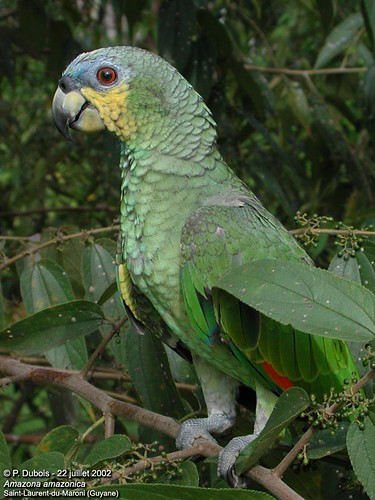
Orange-winged Amazon Parrot, Amazona amazonica.
This is the species of parrot that died from avian infliuenza, H5N1,
in the UK this past week (stories below).
Photograph by Pascal Dubois.
Birds in Science
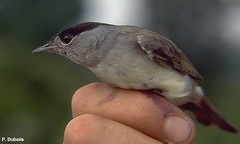 We can put a man on the moon, transplant human hearts, split atoms, create the Internet, cell phones and digital-recording devices, yet we can't fully grasp the intricacies of bird migration nor avian evolution. However, this i9s changing. A population of songbirds that share summer breeding grounds may be dividing into two populations based on where they spend their winters, according to a report in this week's top-tier research journal, Science. European Blackcaps, Sylvia atricapilla (pictured), that follow a new migratory path tend to mate with each other and reproduce more successfully than birds that stick to the traditional route. This split into two breeding groups could increase the likelihood of the birds forming separate species, the authors note. This is the first time biologists have directly observed a mechanism -- selective mate choice -- that is separating a species into two populations, said Pete Marra, a senior scientist at the Migratory Bird Center of the National Zoo in Washington, DC. "To actually have this demonstrated is nice," noted Marra, who was not involved in the study. (If you wish to read more about avian migration generally, this nice little article provides more information about the questions that scientists ask about bird migration.
We can put a man on the moon, transplant human hearts, split atoms, create the Internet, cell phones and digital-recording devices, yet we can't fully grasp the intricacies of bird migration nor avian evolution. However, this i9s changing. A population of songbirds that share summer breeding grounds may be dividing into two populations based on where they spend their winters, according to a report in this week's top-tier research journal, Science. European Blackcaps, Sylvia atricapilla (pictured), that follow a new migratory path tend to mate with each other and reproduce more successfully than birds that stick to the traditional route. This split into two breeding groups could increase the likelihood of the birds forming separate species, the authors note. This is the first time biologists have directly observed a mechanism -- selective mate choice -- that is separating a species into two populations, said Pete Marra, a senior scientist at the Migratory Bird Center of the National Zoo in Washington, DC. "To actually have this demonstrated is nice," noted Marra, who was not involved in the study. (If you wish to read more about avian migration generally, this nice little article provides more information about the questions that scientists ask about bird migration. Birders Helping People
 BirdLife is appealing for donations for the earthquake survivors in the Palas Valley in Pakistan, which is near the epicentre of the earthquake that struck on 8th October. In this valley alone, an estimated 80 people were killed and over 100 badly injured, and 30,000 people face the Himalayan winter without shelter. Most houses collapsed and approximately 3000 people are now living in the open. With the onset of the Himalayan winter, there is tremendous risk of further death and disease among the earthquake survivors. Most displaced households have lost all their belongings, including warm clothes and essentials such as cooking utensils. Food is in short supply. Many of the injured are in upper Palas, which has been always difficult to reach because there are no roads beyond the mouth of the valley (pictured).
BirdLife is appealing for donations for the earthquake survivors in the Palas Valley in Pakistan, which is near the epicentre of the earthquake that struck on 8th October. In this valley alone, an estimated 80 people were killed and over 100 badly injured, and 30,000 people face the Himalayan winter without shelter. Most houses collapsed and approximately 3000 people are now living in the open. With the onset of the Himalayan winter, there is tremendous risk of further death and disease among the earthquake survivors. Most displaced households have lost all their belongings, including warm clothes and essentials such as cooking utensils. Food is in short supply. Many of the injured are in upper Palas, which has been always difficult to reach because there are no roads beyond the mouth of the valley (pictured).People Helping Birds
Some birds under threat of dying out across Britain appear to be making a comeback, according to an important annual survey. According to the government's indicator of 111 wild bird populations for 2004, published last week, total bird numbers across the UK are now almost 10% higher than ten years ago. Bird populations are considered to be a good indicator of the broad state of wildlife and the countryside because they occupy a wide range of habitats and tend to be near or at the top of the food chain. Mark Avery, RSPB director of conservation, said the wild bird indicator was showing its value. "It will become increasingly important as we measure progress towards the Government's target of halting the loss of biodiversity by 2010," he said.
Parrot News
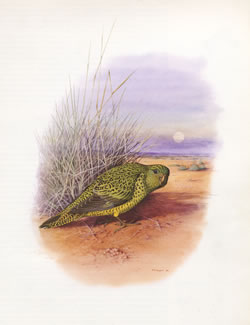 An enigmatic species of Australian parrot - last seen mummified on a Queensland roadside in 1990 - has surfaced at the center of a dispute in the Pilbara region of Western Australia. Ecologists report "very convincing" sightings of three of these critically endangered Night Parrots, Pezoporus occidentalis (pictured left), in marshes at Mulga Downs. Normally, this would be good news, so why the uproar? These ecologists work for Andrew Forrest and they claim the sightings occurred on the pastoral station owned by Australia's richest woman - and Forrest's mining competitor - Gina Rinehart.
An enigmatic species of Australian parrot - last seen mummified on a Queensland roadside in 1990 - has surfaced at the center of a dispute in the Pilbara region of Western Australia. Ecologists report "very convincing" sightings of three of these critically endangered Night Parrots, Pezoporus occidentalis (pictured left), in marshes at Mulga Downs. Normally, this would be good news, so why the uproar? These ecologists work for Andrew Forrest and they claim the sightings occurred on the pastoral station owned by Australia's richest woman - and Forrest's mining competitor - Gina Rinehart.Some of you may remember that I provided many links to stories about New Zealand's mysterious Kakapo, Strigops habroptilus (pictured, below right), in my earlier editions of Birds in the News. A reader sent me a link to this story that reminds us that the Kakapo resumed breeding in February of this year. This is wonderful news: the Kakapo is revered in New Zealand as a unique treasure.
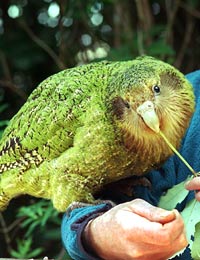 However, this species consists of only 83 known individuals world wide, so this bird is included on the international list of critically endangered species. The Kakapo has a combination of biological features not shared with any other parrot species; it is a large, flightless, nocturnal and eccentric parrot that can live for decades. In addition to their nocturnal habits and their tendency to freeze when imperiled, they have other owl-like features such as soft plumage and almost fur-like discs around their eyes. Kakapos' main defence is their camouflage of mossy green and yellow feathers. Kakapos are the heaviest parrot in the world, with males weighing up to 4 kg. They also are the only parrot in the world to have a ‘lek’ mating system: males compete for specially dug out bowls in ‘calling pits’ and ‘call’ each night for up to four months for a female. The male’s low frequency mating boom travels up to 5 km.
However, this species consists of only 83 known individuals world wide, so this bird is included on the international list of critically endangered species. The Kakapo has a combination of biological features not shared with any other parrot species; it is a large, flightless, nocturnal and eccentric parrot that can live for decades. In addition to their nocturnal habits and their tendency to freeze when imperiled, they have other owl-like features such as soft plumage and almost fur-like discs around their eyes. Kakapos' main defence is their camouflage of mossy green and yellow feathers. Kakapos are the heaviest parrot in the world, with males weighing up to 4 kg. They also are the only parrot in the world to have a ‘lek’ mating system: males compete for specially dug out bowls in ‘calling pits’ and ‘call’ each night for up to four months for a female. The male’s low frequency mating boom travels up to 5 km. Bird Flu News
 Sadly, parrot news and avian influenza news seem to be merging. I am sure that all of you have heard that H5N1 was confirmed in a parrot that died in a UK quarantine station after importation from South America. The parrot imported from Surinam was apparently kept in quarantine with a second parrot imported from Taiwan that was ill with avian influenza. Because of this, and also because of the way in which the influenza tests were performed, there is confusion as to which parrot was truly ill. It is known that the flu strain that killed the parrot(s) is different from the strains from Romania and Turkey and it is not a strain that the Veterinary Laboratory Agency has seen before. In fact, the closest match to the flu that killed this Orange-winged Amazon parrot, Amazona amazonica (pictured), is a strain identified in ducks from China earlier this year. "Our working hypothesis is that any infection in the birds from Surinam is likely to have arisen in the quarantine system, most likely in the facility in Essex where the Surinam birds shared airspace with the birds from Taiwan," said Chief Veterinarian Debby Reynolds. "There are more tests underway on the birds from Taiwan because we have established that some of them died before October 16." But, as expected, Taiwanese officials deny that the parrot was infected by exposure to the Taiwanese poultry. Because the parrot died in quarantine, the UK's "disease free" status remains intact -- news that should help mitigate the widespread panic that has ensued in the UK.
Sadly, parrot news and avian influenza news seem to be merging. I am sure that all of you have heard that H5N1 was confirmed in a parrot that died in a UK quarantine station after importation from South America. The parrot imported from Surinam was apparently kept in quarantine with a second parrot imported from Taiwan that was ill with avian influenza. Because of this, and also because of the way in which the influenza tests were performed, there is confusion as to which parrot was truly ill. It is known that the flu strain that killed the parrot(s) is different from the strains from Romania and Turkey and it is not a strain that the Veterinary Laboratory Agency has seen before. In fact, the closest match to the flu that killed this Orange-winged Amazon parrot, Amazona amazonica (pictured), is a strain identified in ducks from China earlier this year. "Our working hypothesis is that any infection in the birds from Surinam is likely to have arisen in the quarantine system, most likely in the facility in Essex where the Surinam birds shared airspace with the birds from Taiwan," said Chief Veterinarian Debby Reynolds. "There are more tests underway on the birds from Taiwan because we have established that some of them died before October 16." But, as expected, Taiwanese officials deny that the parrot was infected by exposure to the Taiwanese poultry. Because the parrot died in quarantine, the UK's "disease free" status remains intact -- news that should help mitigate the widespread panic that has ensued in the UK.EU veterinary experts will soon discuss plans to ban imports of live captive and pet birds, another measure to prevent the spread of bird flu within the European Union, the EU's health chief said recently. "It will be a general ban, not just on one specific country, on imports of captive birds. And we also have to regulate pet birds ... there has to be control of imports of these birds as they can also transmit disease," EU Health and Consumer Protection Commissioner Markos Kyprianou said at a news conference. The EU imports 1.76 million birds destined to be pets each year, German animal charity Pro Wildlife said. London called for the ban on Sunday after an imported South American parrot died in quarantine in Britain of the virulent H5N1 strain of bird flu that has killed over 60 people in Asia. (Interestingly, not everyone agrees with this ban on importing exotic birds, especially when situations like this one in China, and this one and this one in the UK occur).
After a huge uproar resulted in the wake of Abu Dhabi's announcement that ALL pet cage birds were to be killed in a misguided attempt to prevent the spread of avian influenza, officials in that country finally came to their senses and announced that caged pet birds that do not come in contact with outdoor birds do not have to be destroyed. "Currently our concern is over loose birds in neighborhoods that may potentially have contact with migrating birds. Pet birds kept in enclosed cages at home are of no concern to us," said Mohammad Al Bowardi, Managing Director of the Abu Dhabi Environment Agency. Veterinarians say pet birds kept in private homes are highly unlikely to catch and spread the deadly bird flu virus because they are isolated from wild birds. GrrlScientist notes: One of the most effective ways to ensure rapid spread of avian influenza is to kill pet birds. Because people will go to great lengths to preserve and protect their pets, this overreaction is nothing less than punitive. Pursuing this senseless course of action will only result in reduced public cooperation and will serve to increase people's mistrust of the authorities involved. Further, some agencies are questioning the effectiveness of government-initiated killing of wild birds and draining of wetlands to contain the spread of influenza (these actions certainly have not proven to be particularly effective so far).
Those of you who accept all the media coverage of Bird Flu as being completely accurate will want to read this article which explores this 'accuracy in reporting' issue regarding avian influenza in more rational detail.
 I was surprised to learn this week that most people are unaware that there is a vaccine against avian influenza for use in birds. As you will learn from this linked story, the poultry vaccine against H5N1 is already in wide use in China and Vietnam. GrrlScientist notes: Because of variations between even different isolates of H5N1, vaccinated birds can still become ill with influenza because vaccines are limited to providing protection against only a few strains. Additionally, because influenza viruses evolve so rapidly, vaccines are rapidly outdated, providing protection for older versions of the virus that are no longer in wide circulation.
I was surprised to learn this week that most people are unaware that there is a vaccine against avian influenza for use in birds. As you will learn from this linked story, the poultry vaccine against H5N1 is already in wide use in China and Vietnam. GrrlScientist notes: Because of variations between even different isolates of H5N1, vaccinated birds can still become ill with influenza because vaccines are limited to providing protection against only a few strains. Additionally, because influenza viruses evolve so rapidly, vaccines are rapidly outdated, providing protection for older versions of the virus that are no longer in wide circulation.For the American dog owners who rely on the internet for their news, please be warned that the dangers of a newly discovered dog influenza that mutated from an equine flu virus are being blown out of proportion by pet owners, fueled partly by rumors spread online, veterinarians and researchers say. "It's all over the Internet. The rumors are rampant," says Gail Golab of the American Veterinary Medical Association in Schaumburg, Illinois. The disease was identified in racing greyhounds in 2004 and spread to other canine populations. It moved into the national spotlight when a September 29 paper in the top-tier research journal Science identified it as a mutation of a form of the disease found in horses. If you read this and related blogs very often, dear readers, then you know that influenza has been found in species such as horses, pigs, cats and birds for years, but this is the first canine flu. But even with a high infection rate, dog mortality is low, Cynda Crawford, the veterinary immunologist from the University of Florida College of Veterinary Medicine in Gainesville who first identified the virus, said at a Centers for Disease Control and Prevention briefing. "Despite the rumors that are out on the Internet and other such sources, this disease is not as deadly as people want to make it." Incidentally, there are no reports of either dog or horse influenza ever being transmitted to humans.
Ivory-billed Woodpecker
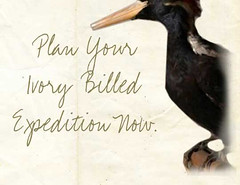 This long but very interesting opinion piece by Keith Sutton notes that before the rediscovery of the Ivory-billed Woodpecker, Campephilus principalis, most people who visited the Big Woods were hunters and fishermen. And most people knew that those hunters and fishermen were the ones primarily responsible for conserving the last large remaining tracts of the Big Woods in Arkansas. Sutton's point? Conservationists and birders owe a huge debt of gratitude to hunters, fishermen and the agencies that their dollars fund because they purchased the majority of the lands now part of the Big Woods. Without this intervention, it is likely the Big Woods would not exist … and neither would the Ivory-billed Woodpecker.
This long but very interesting opinion piece by Keith Sutton notes that before the rediscovery of the Ivory-billed Woodpecker, Campephilus principalis, most people who visited the Big Woods were hunters and fishermen. And most people knew that those hunters and fishermen were the ones primarily responsible for conserving the last large remaining tracts of the Big Woods in Arkansas. Sutton's point? Conservationists and birders owe a huge debt of gratitude to hunters, fishermen and the agencies that their dollars fund because they purchased the majority of the lands now part of the Big Woods. Without this intervention, it is likely the Big Woods would not exist … and neither would the Ivory-billed Woodpecker. Streaming Birds
 Featured this week on BirdNote are answers to those Burning Bird Questions (BBQs) that keep you awake at night; who was the Anna for whom the Anna's Hummingbird, Calypte anna, was named; the rugged life of the Harlequin Duck, Histrionicus histrionicus (pictured, right); step two of feeding wild birds -- keeping your feeders clean; another Native American legend, Why Crow Is Black; and the folklore of owls. BirdNote shows are two-minute vignettes that incorporate the rich sounds of birds provided by Cornell University and by other sound recordists, with photographs and written stories that illustrate the interesting -- and in some cases, truly amazing -- abilities of birds. Some of the shows are Pacific Northwest-oriented, but many are of general interest. BirdNote can be heard Monday through Friday, 8:58-9:00AM, throughout Western Washington and Southwest British Columbia and is also available as RSS/Podcast feeds. All episodes are available in the BirdNote archives, both in written transcript and mp3 formats, along with photographs. [mp3/podcast].
Featured this week on BirdNote are answers to those Burning Bird Questions (BBQs) that keep you awake at night; who was the Anna for whom the Anna's Hummingbird, Calypte anna, was named; the rugged life of the Harlequin Duck, Histrionicus histrionicus (pictured, right); step two of feeding wild birds -- keeping your feeders clean; another Native American legend, Why Crow Is Black; and the folklore of owls. BirdNote shows are two-minute vignettes that incorporate the rich sounds of birds provided by Cornell University and by other sound recordists, with photographs and written stories that illustrate the interesting -- and in some cases, truly amazing -- abilities of birds. Some of the shows are Pacific Northwest-oriented, but many are of general interest. BirdNote can be heard Monday through Friday, 8:58-9:00AM, throughout Western Washington and Southwest British Columbia and is also available as RSS/Podcast feeds. All episodes are available in the BirdNote archives, both in written transcript and mp3 formats, along with photographs. [mp3/podcast]. Holiday Gift Ideas for Your BirdPals
Holiday Gift Ideas for Your BirdPalsThe holidays are coming, so I am including a few links for gift ideas for your bird-loving friends. Because bird flu is such a huge news item this week (even my students were asking me about the infected parrot!), I included a link to the BirdFlu Shop as a potential gift source for your terrified friends. The BirdFlu Shop has some interesting designs, such as the one you see pictured here (right), that the bird lovers on your shopping list might find amusing.
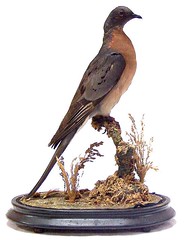 Speaking of (apparently legal) gifts for the bird lover in your life, perhaps this mounted specimen of the extinct Passenger Pigeon, Ectopistes migratorius (pictured, left), might tickle someone's fancy -- and your wallet!
Speaking of (apparently legal) gifts for the bird lover in your life, perhaps this mounted specimen of the extinct Passenger Pigeon, Ectopistes migratorius (pictured, left), might tickle someone's fancy -- and your wallet!For the computer-geek-birder, there is some birder-written software out there designed for identifying birds, called EnjoyBirds. I especially like the sample scroll-over feature shown on this linked page that shows where particular bird species may be found within their habitat. This is PC-only software, so I cannot personally tell you more about the user interface, but the webbed samples certainly looks interesting, and might be a great gift for your birdwatching friends.
Miscellaneous Birds
There has been a lot of chatter on several email lists about the validity of these photos of a preying mantis that has captured and killed a hummingbird. One of the reasons mentioned regarding authenticity of this photograph (courtesy of Pablo and Al), are that that the Mantis has its foreleg claws open. However, other people claim that the photographs are real because there are not any blurry edges around the hummingbird, as one would expect if the photographer had enhanced his work with photoshop. What do you think, dear readers? [As part of this discussion, several papers regarding this phenomenon were cited; Miller and Gass (1985). Survivorship in hummingbirds: Is predation important? Auk 102: 175-178; Johnson (1976). Concerning the feeding habits of the praying mantis Tenodera aridifolia sinensis Saussure. Journal of the Kansas Entomological Society 49: 164; Nickle & Harper (1981). Predation on a mouse by the Chinese mantid Tenodera aridifolia sinensis Saussure (Dictyoptera: Mantoidea). Proceedings of the Entomological Society of Washington 83: 801-802; Holling (1964). The analysis of complex population processes. Canadian Entomology 96:335-347; and a 2001 paper on Belotomatids in Rev. Society of Entomology Argentina. 60:139-146.]
For the fans of San Francisco's Wild Parrots of Telegraph Hill, Mark Bittner, author of the book and star of the film with the same name has a webpage about them that you might enjoy. Includes links to informative pages about these birds and a wav file of the parrots talking to each other.
A singing parrot in the Pennsylvania legislature irked the nerves of a key state senator after the bird was invited to sing by the lieutenant governor. State Senator Robert Jubelirer, the top senator in the legislature, approved the animals' visit but publicly took issue with Lieutenant Governor Catherine Baker Knoll when she allowed the bird to sing.
This long but interesting story from the UCLA student newspaper describes how, in a city of mostly concrete and actresses, there are people who look in mirrors and there are people who look in bushes. UCLA alumnus Jason Finley, a graduate in cognitive science, finds his excitement peering into the latter because Finley is one of UCLA's campus "birders." "I've become fascinated with watching the birds on campus because it has really added a new level of perception to my experience of the world around me," Finley said, moments after spotting a Yellow-rumped Warbler. "It turns out that we're surrounded by birds most of the time and it's something you would probably never even notice unless you started paying attention."
Thanks to my bird pals; Ellen, Pablo and Al, Leslie, Jamie, Phil, Mike, Scott, Rex, Ian, Genny, Jeremy, Marty, Anonymous and Ron for some of the links you are enjoying here.
tags: Birds in the News, ornithology, birds, avian, newsletter
© 2004, 2005, 2006 by GrrlScientist











4 Peer Reviews:
I've played with Photoshop, and worked with many students who were quite proficient with it. There are some techniques for altering photos that would not result in obvious blurred edges around the hummingbird. I do not know if the photos are altered, but Photoshop can do some amazing things.
I love those birds from Australia and New Zealand. Their colors are stunning.
Great round up of the week's bird news. Thank you.
Too much, too much. It is so hard to keep up with your blog. Question, is the European blackcap realted to our chickadee? I think the news about the Australian parrot could lend itself well to a fictionalized movie script!
Am I making a false assumption, or do the Kakapo and Night Parrots seem to have itty-bitty eyes not well suited for nocturnal behavior? Are they more reliant on hearing than vision (which would make sense, considering the linguistic capacity of parrots, I suppose). Mebbe the intelligent designer was too busy patting herself on the back for the Hyacinth to give nocturnal parrots better eyeballs.
Interesting post about hunters/ fishers and the IBW. Strange bedfellows, but organizations like Ducks Unlimited do give a substantive financial boost to conserving bird habitats/ wetlands. Sticky wicket that is, but it does make for unexpected bridges b/t conservationists and huntin' types. I've a foot in both camps, as do many of us in the southeast. The progeny of the theropods bridge the most oddest of social gaps . . .
RD; I am not sure if the photo of the hummer and preying mantis is real, but I do know that preying mantids will capture (and eat?) hummingbirds.
Tabor; do the categories help you to pick and choose which stories to read?
To answer your question, yes, the blackcap is related to our chickadees. And yes, your idea of the Australian parrot would make an interesting story, sort of in the same vein as The Orchid Thief. I'll put on my thinking cap and see what I can some up with .. maybe a short story or two?
Jamie; I am not sure if anyone really knows the full capacity of night parrots' visual abilities but I suspect they do rely on hearing at least somewhat, hence those feathery "discs" around their faces, which are similar to those of owls.
I know quite a few birders who have never held a gun who pay annual dues to Ducks Unlimited because of the conservation work they do. Hopefully, I will find a real job and can then afford to rejoin all my organizations once more, including Ducks Unlimited.
GrrlScientist
Post a Comment
<< Home